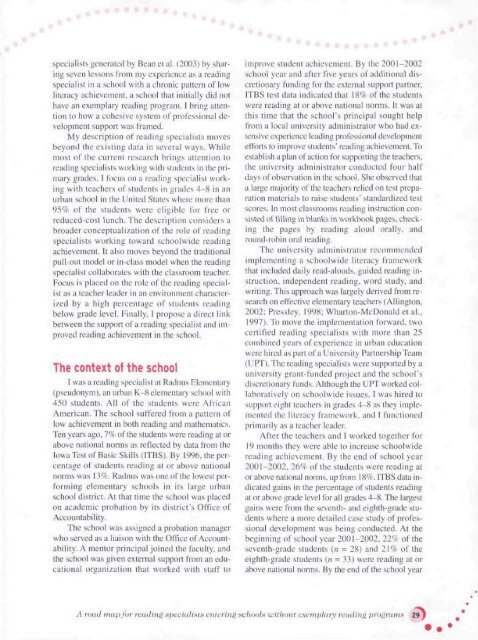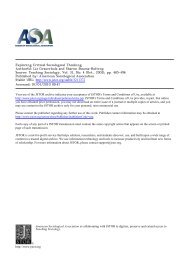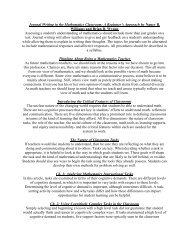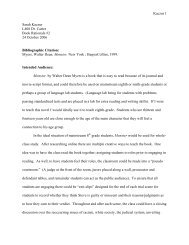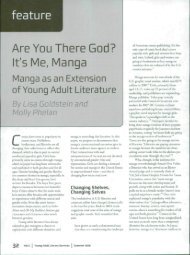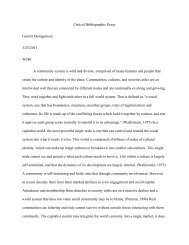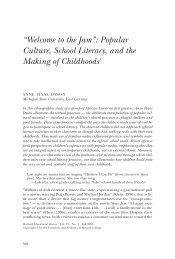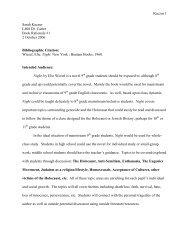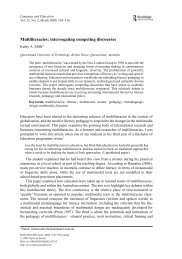A road map for reading specialists entering schools ... - Oncourse
A road map for reading specialists entering schools ... - Oncourse
A road map for reading specialists entering schools ... - Oncourse
You also want an ePaper? Increase the reach of your titles
YUMPU automatically turns print PDFs into web optimized ePapers that Google loves.
<strong>specialists</strong> generated by Bean et ul. {2003) by sharingseven lessons from my experience as a <strong>reading</strong>specialist in a school with a chronic pattern of lowliteracy achievement, a school that initially did nothave an exemplary <strong>reading</strong> program. I bring attentionto how a cohesive system of professional developmentsupport was framed.My de.scription of <strong>reading</strong> <strong>specialists</strong> movesbeyond the existing data in several ways. Whilemost of the current research brings attention to<strong>reading</strong> <strong>specialists</strong> working with students in the primarygrades. I focus on a <strong>reading</strong> specialist workingwith teachers of students in grades 4-8 in anurban school in the United States where more than95% of the students were eligible <strong>for</strong> free orreduced-cost lunch. The description considers ab<strong>road</strong>er conceptualization of the role of <strong>reading</strong><strong>specialists</strong> working toward schooiwide <strong>reading</strong>achievement. It also moves beyond the traditionalpull-out model or in-class model when the <strong>reading</strong>specialist collaborates with the classroom teacher.Focus is placed on the role of the <strong>reading</strong> specialistas a teacher leader in an environment characterizedby a high percentage of students <strong>reading</strong>below grade level. Finally, I propose a direct linkbetween the support of a <strong>reading</strong> specialist and improved<strong>reading</strong> achievement in the school.The context of the schoolI was a <strong>reading</strong> specialist at Radnus Elementary(pseudonym), an urban K-S elementary school with450 students. All of the students were AfricanAmerican. The school suffered from a pattern oflow achievement in both <strong>reading</strong> and mathematics.Ten years ago. 1^/c of the students were <strong>reading</strong> at orabove national norms as reflected by data from theIowa Test of Basic Skills (ITBS). By 1996. the percentageof students <strong>reading</strong> at or above nationalnorms was 13%. Radnus was one ol the lowest per<strong>for</strong>mingelementary <strong>schools</strong> in its large urbanschool district. At that time the school was placedon academic probation by its district's Office ofAccountability.The school was assigned a probation managerwho served as a liaison with the Oftlce of Accountability.A mentor principal joined the faculty, andthe school was given external support from an educationalorganization that worked with staff toimprove student achievement. By the 2001-2002school year and after t1ve years of additional discretionaryfunding <strong>for</strong> the external support partner.ITBS test data indicated that 18% of the studentswere <strong>reading</strong> at or above national norms. It was atthis time that the school's principal sought helpfrom a local university administrator who had extensiveexperience leading professional developmentef<strong>for</strong>ts to improve students' <strong>reading</strong> achievement. Toestablish a plan of action <strong>for</strong> supporting the teachers,the university administrator conducted four halfdays of observation in the school. She observed thata large majority of the teachers relied on test preparationmaterials to raise students' standardized testscores. In most classrooms <strong>reading</strong> instruction consistedof filling in blanks in workbook pages, checkingthe pages by <strong>reading</strong> aloud orally, andround-robin oral <strong>reading</strong>.The university administrator recommendedimplementing a schooiwide literacy frameworkthat included daily read-alouds. guided <strong>reading</strong> instruction,independent <strong>reading</strong>, word study, andwriting. This approach was largely derived from researchon effective elementary teachers (Allington.2002: Pressley. 1998: Wharton-McDonald et al..1997). To move the implementation <strong>for</strong>ward, twocertified <strong>reading</strong> <strong>specialists</strong> with more than 25combined years of experience in urban educationwere hired as part of a University Partnership Team(UPT). The <strong>reading</strong> <strong>specialists</strong> were supported by auniversity grant-funded project and the school'sdiscretionary funds. Although the UPT worked collaborativelyon schooiwide issues. I was hired tosupport eight teachers in grades 4-8 as they implementedthe literacy framework, and I functionedprimarily as a teacher leader.After the teachers and I worked together <strong>for</strong>19 months they were able to increase schooiwide<strong>reading</strong> achievement. By the end of school year2001-2002, 26^^ of the students were <strong>reading</strong> ator above national norms, up from 18%. ITBS data indicatedgains in the percentage of students <strong>reading</strong>at or above grade level <strong>for</strong> all grades 4-8. The largestgains were from the seventh- and eighth-grade studentswhere a more detailed case study of profes-.sional development was being conducted. At thebeginning of school year 2001-2002, 22'^ of theseventh-grade students {n = 28) and 21 % of theeighth-grade students (/? = 33) were <strong>reading</strong> at orabove national nomis. By the end of the school yearA <strong>road</strong> nuip<strong>for</strong> rcadinii si)cciatisis cnCcriui^ scltools \Z'ithim[ cxcnijihiry rcadiuii


